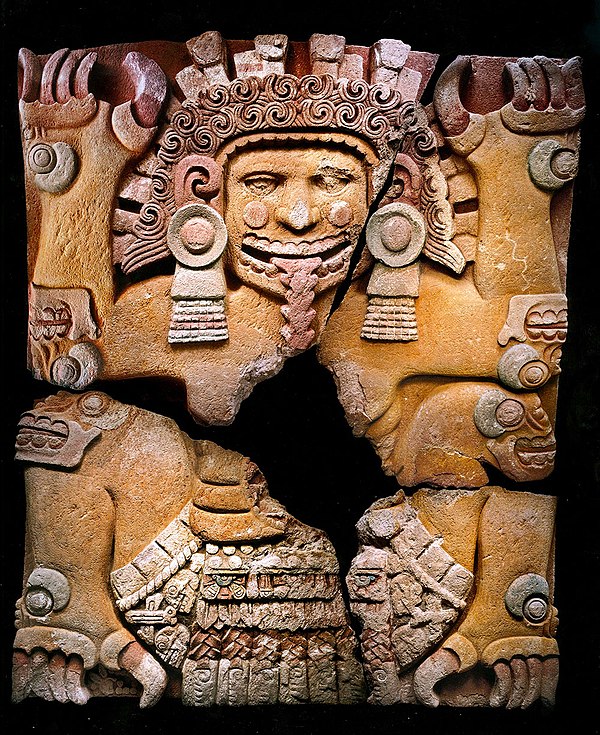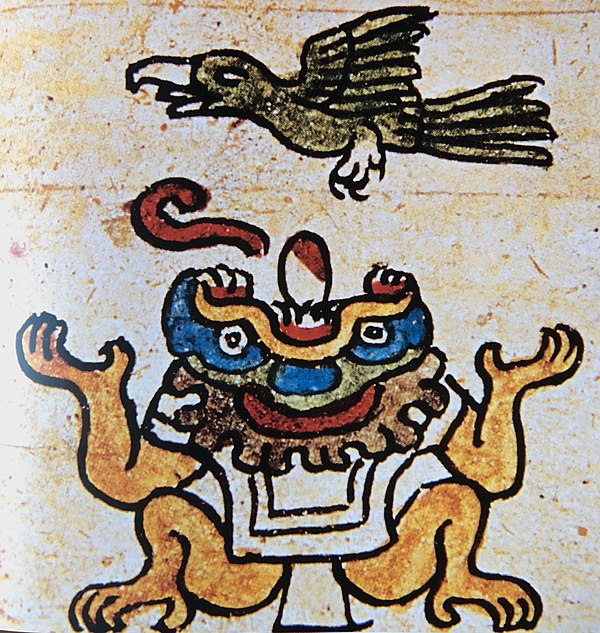No creature as horrible as Tlaltecuhtli – the “embodiment of the chaos that raged before Earth’s creation” – should be allowed to roam the world, decided Mesoamerican gods Quetzalcoatl and Tezcatlipoca. So, the two powerful deities tore the great sea monster in half in a terrific battle. But Tlaltecuhtli survived (although in pieces) and demanded human sacrifice evermore as retribution. The other gods heard of her affliction and took it to be a great injustice. They scattered her dismembered body around the new world to right the wrong. “Her skin became grasses and small flowers, her hair the trees and herbs, her eyes the springs and wells, her nose the hills and valleys, her shoulders the mountains, and her mouth the caves and rivers.”
Thanks to a Yale University student in Dr. Barbara Mundy’s Fall 2018 course, Aztec Art and Architecture, the Wikipedia article about Tlaltecuhtli is robust and fascinating. The student, whose Wikipedia username is Pestocavatappi, made improvements to the article as an assignment, learning the intricacies of Wikipedia editing and community etiquette over 9 weeks. As Dr. Mundy’s course description states, the class focused on how the Aztecs of Mexico “used art and architecture to align themselves to the larger cosmos and to connect their empire to past Mesoamerican civilizations and project it into the future.”

Public domain.
Tlaltecuhtlii’s article had remained relatively unchanged for years before Pestocavatappi began working on it. Back in early October, it was just two paragraphs long with half as many references as the current article cites. Now it boasts six additional images, a clear organization, and information that contextualizes the deity in larger narratives of Aztec mythology and history.
Pestocavatappi uploaded five of the great images now featured in the article, too. One shows a stone carving of Tlaltecuhtli, found in Tenochtitlan (ca. 1500). Another shows Tlaltecuhtli depicted in the Codex Borbonicus, an Aztec text written by priests around the time of Spanish conquest of Mexico. Images can convey additional information about a concept that words can’t; they’re a great addition to an article, especially about art history.

Image: File:Tlaltecuhtli codex painting.jpg, Pestocavatappi, CC BY-SA 4.0, via Wikimedia Commons.
Uploading images to Wikipedia presents different challenges than the technical process of editing text in an article. Wikipedia has strict licensing requirements, prompting necessary discussions of “fair use”, open licenses, and copyright violation. In addition to our uploading images training, we’ve developed a handout for art history students that walks through these distinctions. Dr. Mundy was one of the instructors who we consulted in the production of that handout, and we thank her again!
To see what other articles Dr. Mundy’s students improved this last term, check out their course page on our Dashboard.
For more information about teaching with Wikipedia, visit teach.wikiedu.org or reach out to contact@wikiedu.org.
